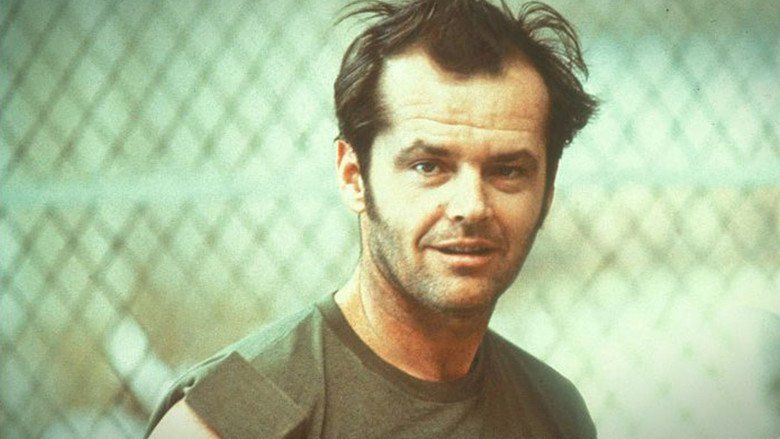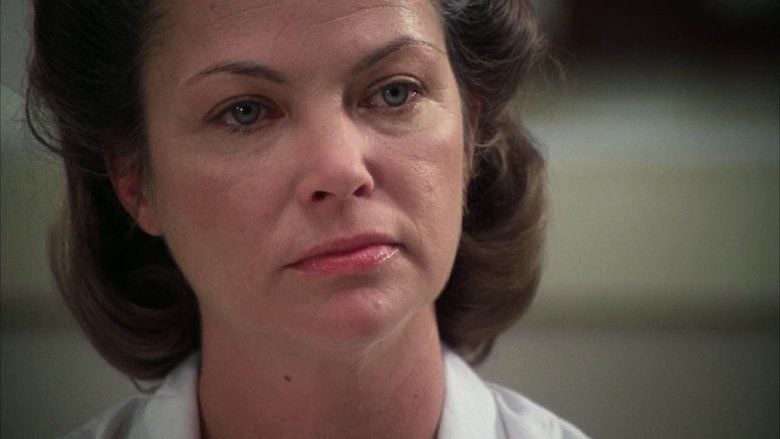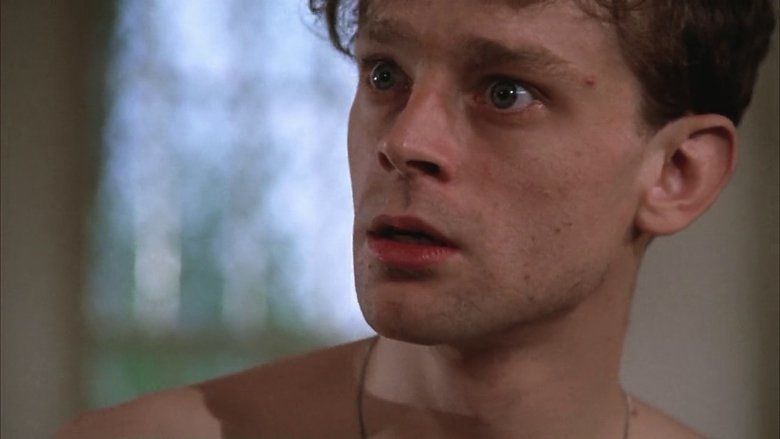One Flew Over the Cuckoos Nest (film)
7 /10 2 Votes9
95% Rotten Tomatoes 79% Metacritic Genre Drama Country United States | 8.7/10 IMDb 4/4 Roger Ebert Director Milos Forman Duration Language English | |||||||||||||||||||||||||||||||||
 | ||||||||||||||||||||||||||||||||||
Release date November 19, 1975 (1975-11-19) Writer Lawrence Hauben (screenplay), Bo Goldman (screenplay), Ken Kesey (based on the novel by), Dale Wasserman (the play version: "One Flew Over the Cuckoos Nest" by) Cast (Randle Patrick McMurphy), (Nurse Mildred Ratched), (Martini), (Harding), (Orderly Turkle), (Billy Bibbit) Similar movies Alien , Rain Man , Leaving Las Vegas , Cool Hand Luke , East of Eden , Lost Highway Tagline If he's crazy, what does that make you? | ||||||||||||||||||||||||||||||||||
One flew over the cuckoo s nest 1975 official trailer 1 jack nicholson movie hd
One Flew Over the Cuckoo's Nest is a 1975 American comedy-drama film directed by Miloš Forman, based on the 1962 novel One Flew Over the Cuckoo's Nest by Ken Kesey. The film stars Jack Nicholson, and features a supporting cast of Louise Fletcher, William Redfield, Will Sampson and Brad Dourif.
Contents
- One flew over the cuckoo s nest 1975 official trailer 1 jack nicholson movie hd
- One flew over the cuckoos nest full movie
- Plot
- Production
- Casting
- Rehearsals
- Filming
- Reception
- Others
- References

Considered to be one of the greatest films ever made, One Flew Over the Cuckoo's Nest is No. 33 on the American Film Institute's 100 Years... 100 Movies list. The film was the second to win all five major Academy Awards (Best Picture, Actor in Lead Role, Actress in Lead Role, Director, and Screenplay) following It Happened One Night in 1934, an accomplishment not repeated until 1991 by The Silence of the Lambs. It also won numerous Golden Globe and BAFTA Awards.

In 1993, the film was deemed "culturally, historically, or aesthetically significant" by the United States Library of Congress and selected for preservation in the National Film Registry.

One flew over the cuckoos nest full movie
Plot

In 1963 Oregon, recidivist criminal Randle McMurphy is moved to a mental institution after serving a short sentence on a prison farm for statutory rape of a 15-year-old. Though not actually mentally ill, McMurphy hopes to avoid hard labor and serve the rest of his sentence in a relaxed environment. Upon arriving at the hospital, he finds the ward run by the steely, strict Nurse Ratched, who subtly suppresses the actions of her patients through a passive-aggressive routine, intimidating the patients.

The other patients include anxious, stuttering Billy Bibbit; Charlie Cheswick, who is prone to childish tantrums; delusional Martini; the well-educated, paranoid Dale Harding; belligerent Max Taber; epileptic Jim Sefelt; and “Chief” Bromden, a tall Native American believed to be deaf and mute. Ratched soon sees McMurphy’s lively, rebellious presence to be a threat to her authority, confiscating the patients’ cigarettes and rationing them. During his time in the ward, McMurphy gets into a battle of wits with Ratched. He steals a hospital bus, escaping with several patients to go on a fishing trip, encouraging his friends to become more self-confident.

McMurphy learns his sentence may become indefinite, and he makes plans to escape, exhorting Chief to throw a hydrotherapy cart through a window. He, Chief, and Cheswick get into a fight with the orderlies after the latter becomes agitated over his stolen cigarettes. Ratched sends them to the “shock shop,” and McMurphy discovers Chief can actually speak, feigning illness to avoid engaging with anyone. After being subjected to electroconvulsive therapy, McMurphy returns to the ward pretending to have brain damage, but reveals the treatment has charged him up even more. McMurphy and Chief make plans to escape, but decide to throw a secret Christmas party for their friends after Ratched leaves for the night.

McMurphy sneaks two women, Candy and Rose, into the ward and bribes the night guard. After a night of partying, McMurphy and Chief prepare to escape, inviting Billy to come with them. He refuses, not ready to leave the hospital. McMurphy instead convinces him to have sex with Candy. Ratched arrives in the morning to find the ward in disarray and most of the patients unconscious. She discovers Billy and Candy together, the former now free of his stutter, until Ratched threatens to inform his mother about his escapade. Billy is overwhelmed with fear and locks himself in the doctor’s office and commits suicide. The enraged McMurphy chokes Ratched, before being knocked out by an orderly.

Ratched comes back with a neck brace and a scratchy voice. Rumors spread that McMurphy escaped rather than be taken “upstairs.” Later that night, Chief sees McMurphy being returned to his bed. He discovers McMurphy has lobotomy scars on his forehead, and smothers his friend with a pillow. Chief finally throws the hydrotherapy cart through the window and escapes into the night, cheered on by Taber.
Production
Actor Kirk Douglas—who had originated the role of McMurphy in the 1963–64 Broadway stage version of the Ken Kesey novel—had purchased the film rights to the story and tried for a decade to bring it to the big screen, but was unable to find a studio willing to make it with him. Eventually, he gave the rights to his son Michael Douglas, who succeeded in getting the film produced–but the elder Douglas, by then nearly 60, was considered too old for the McMurphy role, which ultimately went to 38-year old Jack Nicholson.
Douglas bought in Saul Zaentz as co-producer.
The film's first screenwriter, Lawrence Hauben, introduced Douglas to the work of Miloš Forman, whose 1967 Czechoslovak film The Firemen's Ball had the sort of qualities they were looking for. Forman flew to California and went through the script page by page and outlined what he would do, in contrast with other directors who had been approached who were less than forthcoming. Saul Zaentz, a voracious reader, felt an affinity with Kesey, and so after Hauben's first attempt he asked Kesey to write the screenplay, and promised him a piece of the action, but it didn’t work out and ended in a financial dispute.
Hal Ashby, who had been an early consideration for director, suggested Jack Nicholson for the role of McMurphy. Production was delayed for about six months because of Nicholson’s schedule. However, Douglas later felt that this ended up as a blessing as it gave more time to get the ensemble right.
Casting
Danny DeVito, who was Douglas's oldest friend, was the first to be cast as he had played Martini, one of the patients, in the 1971 off-Broadway production. Douglas found Will Sampson, who played Chief Bromden, through a used car dealer that Douglas was sitting next to on an aircraft. Douglas had told him that they were looking for a big guy to play the chief. He sold a lot of cars to Native Americans and six months later rang Douglas to say: “the biggest sonofabitch Indian came in the other day!”
Miloš Forman had considered Shelley Duvall for the role of Candy. While screening Thieves Like Us (1974) to see if she was right for the role, he became interested in Louise Fletcher, who had a supporting role, for the role of Nurse Ratched. A mutual acquaintance, the casting director Fred Roos, had already mentioned her name as a possibility. Even so it took four or five meetings, over a year, (during which the role was offered to other actresses) for Fletcher to secure the role of Nurse Ratched. Her final audition was late in 1974, with Forman, Zaentz and Douglas. The day after Christmas, her agent called to say she was expected at the Oregon State Hospital in Salem on 4 January to begin rehearsals.
Rehearsals
Prior to commencement of filming a week of rehearsals started on 4 January 1975 in Oregon, during which the actors watched the patients in their daily routine and at group therapy. Jack Nicholson and Louise Fletcher also witnessed electroconvulsive therapy on a patient.
Filming
Other than Nicholson, the rest of the cast were working for scale, or a little above that. Fletcher worked for 11 weeks and made $10,000 before taxes.
Filming began in January 1975 and concluded approximately three months later, and was shot on location in Salem, Oregon and the surrounding area, as well as on the Oregon coast.
The producers decided to shoot the film in the Oregon State Hospital, an actual mental hospital, as this was also the setting of the novel. The hospital’s director, Dean Brooks, was supportive of the filming and eventually ended up playing the character of Dr. John Spivey in the film. Brooks identified a patient for each of the actors to shadow, and some of the cast even slept on the wards at night. He also wanted to incorporate his patients into the crew, to which the producers agreed. Douglas recalls that it wasn't until later that he found out that many of them were criminally insane.
As Forman didn't allow the actors to see the day’s filming, this led to the cast losing confidence in him, while Nicholson also began to wonder about his performance. Douglas convinced Forman to show Nicholson something, which he did, and restored the actor's confidence.
Haskell Wexler was fired as cinematographer and replaced by Bill Butler. Wexler believed his dismissal was due to his concurrent work on the documentary Underground, in which the radical terrorist group The Weather Underground were being interviewed while hiding from the law. However, Miloš Forman said he had terminated Wexler over artistic differences. Both Wexler and Butler received Academy Award nominations for Best Cinematography for One Flew Over the Cuckoo's Nest, though Wexler said there was "only about a minute or two minutes in that film I didn't shoot.”
According to Butler, Jack Nicholson refused to speak to Forman: "...[Jack] never talked to Miloš at all, he only talked to me."
Filming went over the initial budget of $2m and over-schedule, but Saul Zaentz, who was personally financing the movie, was able to fund this by borrowing against his company, Fantasy Records. The movie cost in total $4.4m to make.
Reception
The film was met with overwhelming critical acclaim; Roger Ebert said "Miloš Forman's One Flew Over the Cuckoo's Nest is a film so good in so many of its parts that there's a temptation to forgive it when it goes wrong. But it does go wrong, insisting on making larger points than its story really should carry, so that at the end, the human qualities of the characters get lost in the significance of it all. And yet there are those moments of brilliance." Ebert would later put the film on his "Great Movies" list. A.D. Murphy of Variety wrote a mixed review as well, as did Vincent Canby: writing in The New York Times, Canby called the film "a comedy that can't quite support its tragic conclusion, which is too schematic to be honestly moving, but it is acted with such a sense of life that one responds to its demonstration of humanity if not to its programmed metaphors."
The film opens with original music by composer Jack Nitzsche, featuring an eerie bowed saw (performed by Robert Armstrong) and wine glasses. Commenting on the score, reviewer Steven McDonald has said, "The edgy nature of the film extends into the score, giving it a profoundly disturbing feel at times -- even when it appears to be relatively normal. The music has a tendency to always be a little off-kilter, and from time to time it tilts completely over into a strange little world of its own ..."
The film went on to win the "Big Five" Academy Awards at the 48th Oscar ceremony. These include the Best Actor for Jack Nicholson, Best Actress for Louise Fletcher, Best Direction for Forman, Best Picture, and Best Adapted Screenplay for Lawrence Hauben and Bo Goldman. The film currently has a 95% "Certified Fresh" rating at Rotten Tomatoes with an average rating of 9/10. Its consensus states "The onscreen battle between Jack Nicholson and Louise Fletcher serves as a personal microcosm of the culture wars of the 1970s -- and testament to the director's vision that the film retains its power more than three decades later."
One Flew Over the Cuckoo's Nest is considered to be one of the greatest American films. Ken Kesey participated in the early stages of script development, but withdrew after creative differences with the producers over casting and narrative point of view; ultimately he filed suit against the production and won a settlement. Kesey himself claimed never to have seen the movie, but said he disliked what he knew of it, a fact confirmed by Chuck Palahniuk who wrote, "The first time I heard this story, it was through the movie starring Jack Nicholson. A movie that Kesey once told me he disliked."
In 1993, this film was deemed "culturally, historically, or aesthetically significant" by the United States Library of Congress and selected for preservation in their National Film Registry.
Others
American Film Institute
References
One Flew Over the Cuckoo's Nest (film) WikipediaOne Flew Over the Cuckoos Nest (film) IMDbOne Flew Over the Cuckoos Nest (film) Rotten TomatoesOne Flew Over the Cuckoos Nest (film) Roger EbertOne Flew Over the Cuckoos Nest (film) MetacriticOne Flew Over the Cuckoos Nest (film) themoviedb.org
